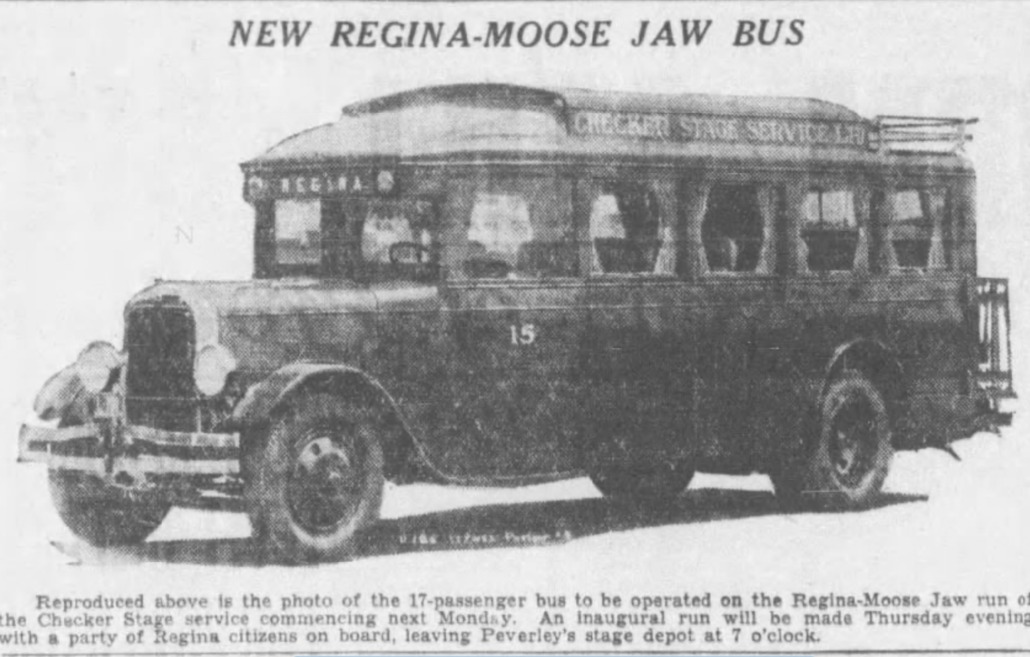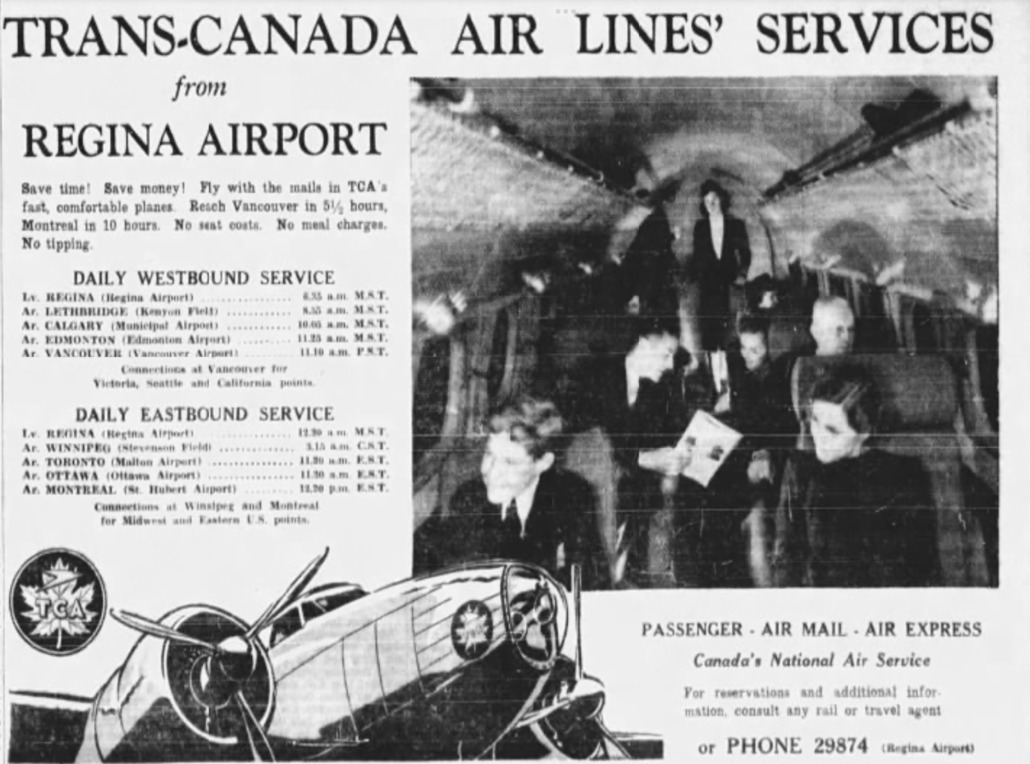Regina’s First Cross-Country Air Service
By Tom Fuzesy
Sunday, April 2, 1939: It is a chilly night, just after midnight. Trans-Canada Airlines (TCA) flight 2 pierces the night sky and lands at the Regina Municipal Airport, arriving after a two-hour flight from Lethbridge. The aircraft is a 10-passenger Lockheed Electra 10A on its eastbound flight across Canada, from Vancouver to Montreal. It is the very first cross-country passenger flight ever to service the Queen City.
Prior to commercial air travel, trains were the primary mode of long-distance travel. Trains were important for connecting the east and west provinces across Canada’s vast distances. Regina’s newcomer boom in the 1880s was possible only though the construction of the Canadian Pacific Railway across the country, and through Regina.
The twentieth century saw the popularity of cars increasing, and more people were replacing their horse-driven conveyances. Long-distance motoring, however, came with many challenges, including the state of the roads, which were often impassable in wet or snowy weather. In Regina, inter-city bus service began in the late 1920s with a local taxi company. Checker Taxi provided scheduled service from Regina to Milestone and Moose Jaw. In the early 1930s, Greyhound Bus Lines began providing inter-provincial bus service, connecting Saskatchewan to its prairie neighbours, Alberta and Manitoba.

The new Checker Stage bus service between Regina and Moose Jaw, as seen in the Leader-Post on June 18, 1931.
In Regina, on that chilly April night in 1939, three passengers deplane and an equal number board. A brief ceremony takes place with mayor Alban Ellison, who puts the city’s seal onto a parchment scroll, commemorating Regina as one of the stops on this historic flight. Soon, the plane takes off into the darkness, continuing its journey east towards Winnipeg.
The first westbound flight, TCA flight 1, arrives in Regina about six hours later from Winnipeg. After a 10-minute stop, it continues westbound to Lethbridge, ultimately bound for Vancouver. One of the TCA route’s selling points was the speed of air travel, with the schedule promising to get passengers from Regina to Vancouver, Toronto or Montreal in time for lunch. At the time, Lethbridge was TCA’s Alberta hub. Today, of course, Calgary and Edmonton’s International Airports have eclipsed Lethbridge’s humble trans-Canada beginnings.
For these early cross-Canada flights, weather was a constant concern and schedules were always at the whim of Mother Nature. The first eastbound flight was grounded in Ottawa when snow prevented the onward flight to Montreal—passengers had to take a train instead into Quebec. Bad weather over British Columbia grounded the first two westbound flights in Lethbridge, as well as the second eastbound flight in Vancouver. It was, therefore, remarkable that the first east and westbound flights through Regina were (for the most part) on time.
Although this was the first cross-country passenger air service for Regina, it was not the first passenger service overall. In the late 1920s, a Winnipeg-based airline called Western Canada Airways started an air mail service from Winnipeg to Banff, with stops in Regina. These mail routes sometimes carried up to four passengers. On August 4, 1938, Prairie Airways started a passenger service connecting Regina with other Saskatchewan cities. Using a seven-passenger Beechcraft plane, it flew a daily circuit of Regina, Moose Jaw, Saskatoon, Prince Albert, and North Battleford. Even after TCA began cross-country service in Regina, these routes allowed passengers from throughout Saskatchewan to connect to TCA flights in Regina. TCA began routes through Saskatoon as well in 1947.
At the beginning of trans-Canada air service, only the wealthiest could afford to fly. Fares were initially priced at 6 cents per mile, with a 10% reduction for round trip fares. That meant that a round-trip airfare from Regina to Vancouver was $90.25, which would be around $2,000 in today’s prices. A return trip to Ottawa was $158.20, or $3,500 today. In comparison, a round-trip train ticket from Regina to Vancouver in 1939 was $25.10 — $512 today, and $65 cheaper than flying.
Regina’s airport was built in 1930 and was considered one of Canada’s best airports. It was notable for its large hangar, rainproof runways, and dedication to safer night flying with lights and beacons illuminating the runways at night. What Regina’s airport didn’t have, however, was a terminal building able to handle increasing numbers of air passengers. When significant commercial air service started in 1938, a makeshift waiting room was created. It was a small, heated space in the southeast corner of the hangar, furnished with sofas and chairs, enough to accommodate the handful of passengers on any given day. However, additional flights and larger planes meant that a new terminal was required. Within a year of the start of TCA’s service, a new terminal, called the Administration Building, was built, opening in February 1940. It served Regina for 20 years.
Today, nearly 85 years later, the Regina International Airport continues to connect the city with the rest of North America, moving a pre-pandemic average of 1.2 million passengers per year. Having grown substantially since the first cross-country TCA service in 1939, the airport boasts a modern terminal serving several commercial airlines – including TCA, who you might know as Air Canada (the name was changed in 1965).
Tom Fuzesy is a volunteer for Heritage Regina and is an avid sports fan, researcher, and local historian.


The two Beech 18s used by Prairie Airways on its North-South run in Saskatchewan still exist — in very good condition. One’s in the Pima County Air Museum in Tucson and the other is in the Beech Staggerwing Museum in Tullahoma, Tennessee. The Western Development Museum tried to acquire one of them in the early 1990s, but the owner got greedy and there was no deal to be made.